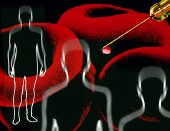
SATURDAY, June 5 (HealthDay News) — Two new drugs, dasatinib (Sprycel) and nilotinib (Tasigna), appear better than imatinib (Gleevec) in treating patients with newly diagnosed chronic myeloid leukemia and should be considered as first-line treatments, two new studies show.
The findings, which should change clinical practice, are to be presented Saturday at the American Society of Clinical Oncology annual meeting in Chicago and were simultaneously published online June 5 in the New England Journal of Medicine.
“Both next-generation inhibitors of BCR-ABL [dasatinib and nilotinib] are superior to Gleevec in treating chronic myeloid leukemia when compared head-to-head after one year of follow-up,” said Dr. Charles L. Sawyers, chair of the Human Oncology and Pathogenesis Program at the Howard Hughes Medical Institute at Memorial Sloan-Kettering Cancer Center in New York City and author of an accompanying journal editorial.
“This magnitude of success — beating a drug like imatinib [Gleevec] that was already pretty great — is possible because we have a very precise understanding of the drug target BCR-ABL and of the mechanisms of resistance to imatinib,” Sawyers added.
Newly diagnosed chronic myeloid leukemia patients should probably now be treated with one of the new drugs instead of imatinib, he noted.
In the first study, a team led by Dr. Hagop Kantarjian, chairman of the leukemia department at the University of Texas M.D. Anderson Cancer Center in Houston, randomly assigned 519 patients to Sprycel or Gleevec.
After a year, 77 percent of the patients receiving Sprycel had a complete cytogenetic response, compared with 66 percent of the patients receiving Gleevec, the researchers found.
Complete cytogenetic response is the disappearance of all the cancer cells from the bone marrow, Kantarjian explained.
In addition, the rate of major molecular response was higher among those taking Sprycel (46 percent) than those taking Gleevec (28 percent). Moreover, patients responded faster to Sprycel than to Gleevec, the researchers noted. A major molecular response is a 99.9 percent reduction of the disease, Kantarjian noted.
“The data we have suggests that perhaps dasatinib [Sprycel] therapy could be first-line treatment for chronic myeloid leukemia,” Kantarjian said.
The safety of both drugs was similar, however, with five patients receiving Sprycel and nine patients receiving Gleevec seeing their disease progress.
The patients in the study continue to receive treatment and are being followed to see if there is a relapse, Kantarjian said.
Currently, Sprycel is approved for use only in patients who have failed Gleevec treatment. Sprycel is made by Bristol-Myers Squibb and Gleevec is made by Novartis Pharmaceuticals.
“We have new treatments that are better than Gleevec,” Kantarjian said. “These new treatments could become front-line therapy for chronic myeloid leukemia soon.”
In the second report, Italian researchers randomly assigned 846 patients to Tasigna or Gleevec.
After one year, more patients — about 80 percent of those receiving Tasigna — had a complete cytogenetic response, compared with 65 percent of the patients receiving Gleevec, the researchers found.
“Nilotinib [Tasigna] has been tried as first-line therapy for patients and has, indeed, produced more responses and better outcomes for patients,” said lead researcher Dr. Giuseppe Saglio, a professor of internal medicine and hematology at the University of Turin and San Luigi Gonzaga Hospital in Italy.
Tasigna is also made by Novartis Pharmaceuticals.
“In less than 10 years, we have come up with nearly ideal drugs for treating chronic myeloid leukemia,” Sawyers noted. “Many other cancers — lung, melanoma, sarcoma — are caused by mutations in similar genes and are being treated with drugs similar to imatinib [Gleevec]. The success in chronic myeloid leukemia predicts for similar success in these other diseases.”
Another expert, Dr. Marshall A. Lichtman, a professor of medicine, biochemistry and biophysics at the University of Rochester Medical Center in Rochester, N.Y., said that “there have been good reasons to consider nilotinib [Tasigna] or dasatinib [Sprycel] as upgrades to imatinib [Gleevec] in the treatment of BCR-ABL-positive chronic myeloid leukemia.”
Since their availability, they have been shown to be able to rescue patients who did not respond or lost their response to Gleevec, he said.
“We now have formal evidence through phase 3 clinical trials that either dasatinib [Sprycel] or nilotinib [Tasigna] increase the rate of complete cytogenetic remission and of a major molecular remission, the later a more sensitive measure of residual leukemic cells during therapy,” Lichtman said.
“The one remaining question is will the 12-month results translate into 12-year results?” he said. “The experienced observer would predict yes, but the experienced observer also knows that seeing is believing. We should have a pretty good idea in a few more years about the long-term response in comparison to imatinib [Gleevec].”
The evidence from these studies, along with many prior observations of their effectiveness, should lead the U.S. Food and Drug Administration to consider approving them for newly diagnosed patients, Lichtman said.
More information
For more information on chronic myeloid leukemia, visit the U.S. National Institutes of Health.

